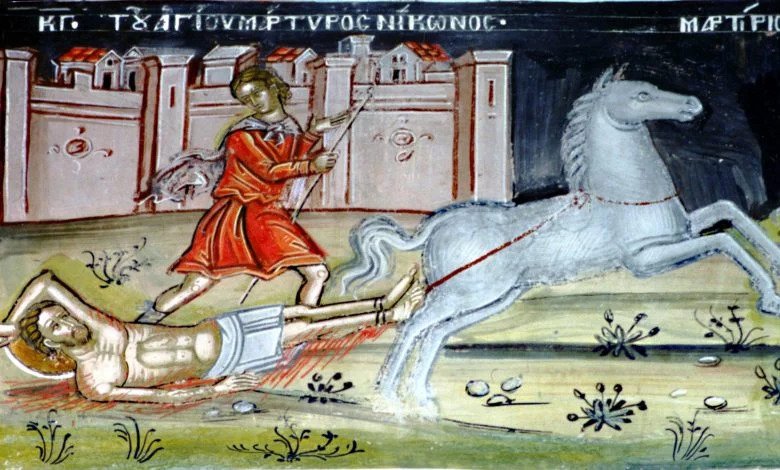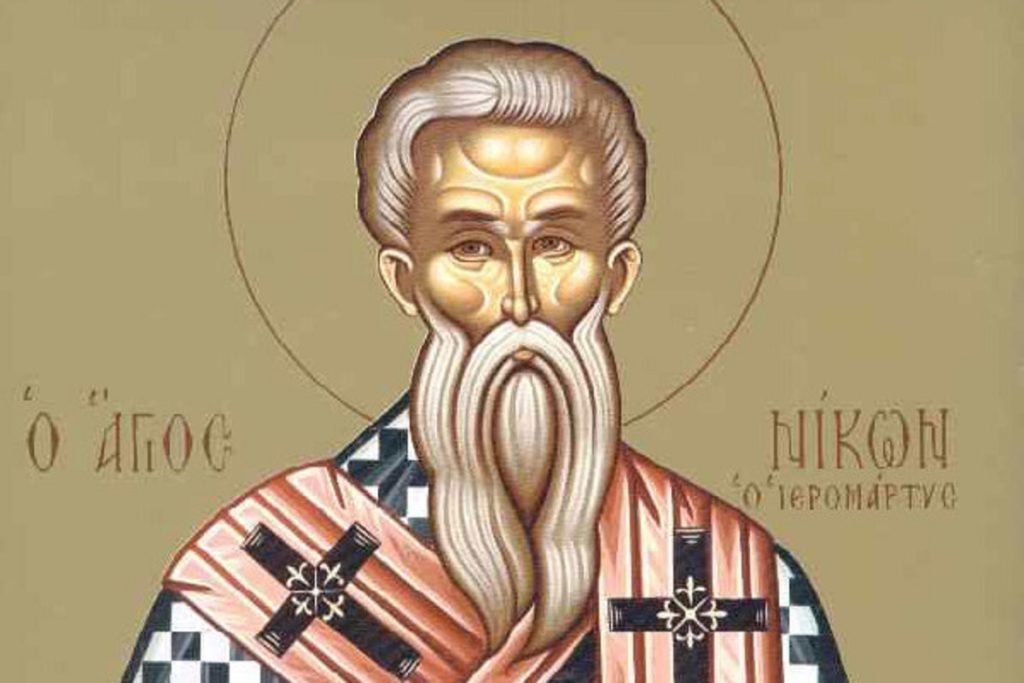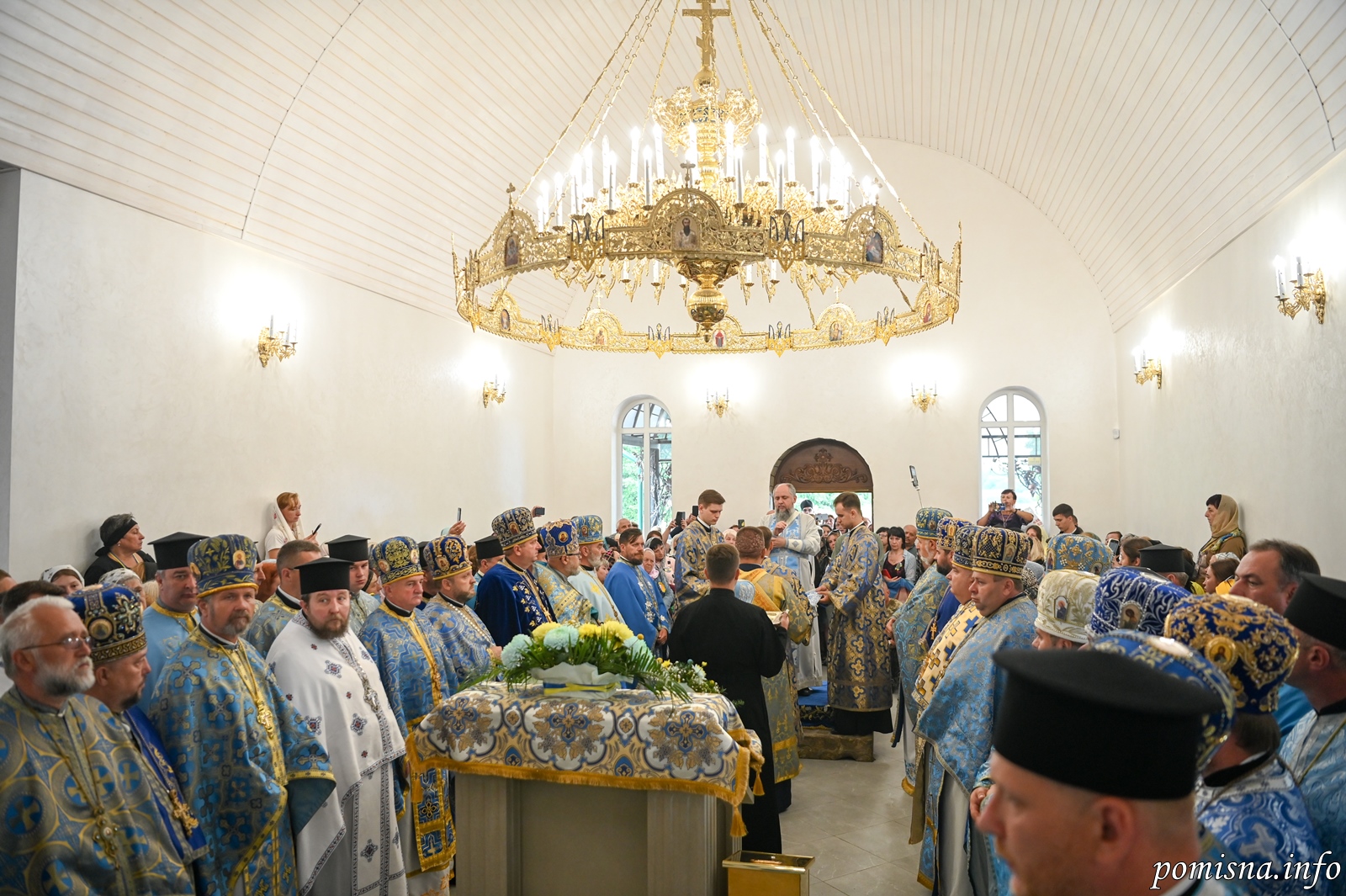Martyr Nikon and 199 disciples with him in Sicily (23 March)


The Monk Martyr Nikon was born at Neapolis (Naples). His father was a pagan, and his mother a Christian. He was not baptized, but his mother secretly instructed him in the tenets of Christianity. Nikon was still a pagan when he reached adulthood. He served as a soldier, and showed unusual courage and strength.
Once, Nikon and his military company were surrounded by enemies. In deadly peril, he remembered the Christian precepts of his mother and, signing himself with the Sign of the Cross, he prayed to God, vowing to be baptized if he were saved. Filled with unusual strength, he killed many of the enemy, and put the rest to flight.
He managed to return home, giving thanks to God for preserving his life. With the blessing of his mother, he set off in search of a priest. This was no easy thing to do in a time of persecution. Saint Nikon took a ship to the island of Chios. He went up on a high mountain and spent eight days in fasting and prayer, entreating the Lord to help him.
An angel of God appeared to Saint Nikon in a dream, showing him the way. Saint Nikon went to Mount Ganos, where many monks were hidden, headed by Theodosius the Bishop of Cyzicus. Saint Nikon received from the bishop both the mystery of Baptism and the angelic schema (i.e., monastic tonsure). Living in the cave church, Saint Nikon became an example for all the brethren.
When Saint Nikon had lived on the mountain for three years, an angel revealed to the bishop that Saint Nikon should be consecrated bishop, and should move to the province of Sicily with all the monks. Bishop Theodosius obeyed the angel, and then died after he had entrusted the 190 monks to Saint Nikon. After he buried Bishop Theodosius, Saint Nikon sailed to Sicily with the brethren, and so was saved from approaching barbarians.
By God’s grace, Saint Nikon came to his native city Neapolis. He found his mother still alive, and he remained with her for the final day of her life. His mother collapsed on his chest with tears of joy and kissed him. Making a prostration to the ground, she said, “I give thanks to You, O Lord, for You have permitted me to see my son as a monk, and as a bishop. Now, my Lord, hear Your servant, and receive my soul.” When she had finished this prayer, the righteous woman died. Those present glorified God and buried her with psalmody.
Rumors of Saint Nikon’s arrival spread through the city, and ten soldiers, his former companions, came to see him. After conversing with the saint they believed and were baptized, and went with him to Sicily. Having arrived on the island, Saint Nikon settled with the monks in a desolate area, called Gigia, near the river Asinum.
Many years passed, and there was another persecution against Christians. Quintilian, the governor of Sicily, was informed that Bishop Nikon was living nearby with many monks. All 199 monks were seized and beheaded, but they left Saint Nikon alive in order to torture him.


They burned him with fire, yet he remained unharmed. They tied him to the tails of wild horses to be dragged over the ground, but the horses would not budge from the spot. They cut out the saint’s tongue, threw him off a high cliff, and finally beheaded him. The body of the hieromartyr Nikon was left in a field to be eaten by wild beasts and birds.
A certain shepherd, possessed by an evil spirit, went to that place, and finding the body of the saint, he immediately fell to the ground on his face. The unclean spirit, vanquished by the power of the saint, had thrown him to the ground and gone out from him with a loud shriek: “Woe is me, woe is me, where can I flee from Nikon?”
The healed shepherd related this to the people. The bishop of the city of Messina also learned of this, then he and his clergy buried the bodies of Saint Nikon and his disciples.
Saint Nicon was from Neapolis (Naples) in Italy. His father was an idolater and his mother a Christian. At first he was a soldier, but later he went to the East, where he was baptized and in time became a bishop. After some years, he returned to the West and came to Sicily, where he and many of his disciples were put to death by beheading because they would not worship the idols.
Nicon was born in Naples of a pagan father and Christian mother. He was a Roman officer in Naples and was unbaptized, even though his mother tutored him in the Christian Faith, hiding this from his father. Once, when Nicon was sent into battle with his troops, his mother counseled him to make the sign of the Cross and to call upon Christ for help if any misfortune should befall him. And, indeed, when during the battle Nicon’s troops were completely surrounded and extremely close to final destruction, Nicon made the sign of the Cross and in his heart cried out to Christ. Immediately he was filled with extraordinary strength and pursued his enemies. Some he slew, and others he forced to flee. Returning to his home, Nicon continuously cried out in amazement: “Great is the Christian God.”
After he had made his mother happy with the news of his victory with the help of the Cross of Christ, he secretly sailed to Asia. There he was baptized by Theodosius, Bishop of Cyzicus. Following his baptism, he secluded himself in a monastery, where he devoted himself to study and asceticism. Before his death Theodosius had a vision in which he was told to ordain Nicon as his successor. Immediately the aged Theodosius summoned Nicon and ordained him a deacon, then a priest, and finally a bishop. Shortly thereafter, according to God’s providence, Nicon came to Naples where he discovered that his mother was still living. Following his mother’s death, Nicon withdrew to Sicily with nine disciples, his former military companions. There he dedicated himself to preaching the Gospel.
At that time, however, there was a terrible persecution of Christians. Prince Quintianus captured Nicon with his companions and inflicted great pain and suffering upon them. Nicon’s 199 disciples and companions were beheaded. The tormentor tied Nicon to the tails of horses, hurled him from a steep wall into a gorge, beat him, and skinned him. Nicon, however, survived all of these tortures. Finally, he was beheaded and took up his habitation with the Lord. His body was left in the fields to be devoured by the birds. A certain herdsman, possessed by a violent evil spirit, tripped and fell over the body of Christ’s martyr, and was immediately healed. He proclaimed the news about Nicon’s body, and Christians came forth and honorably buried it. St. Nicon suffered during the reign of the Emperor Decius.
Apolytikion of Martyr Nicon & the 199
Fourth Tone
O God of our Fathers, ever dealing with us according to Thy gentleness: take not Thy mercy from us, but by their entreaties guide our life in peace.
Source: oca.org / goarch.org / westserbdio.org




